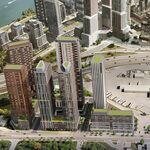A
AlvinofDiaspar
Guest
From the Star:
Nurture T.O.'s creativity, report urges
Jul. 24, 2006. 05:35 AM
VANESSA LU
CITY HALL BUREAU CHIEF
Toronto could be one of the world's great cities for artists and scientists, but it must take aggressive strategic steps to make the best use of its existing talent and encourage new thinking, a report says.
Such steps would include better access to funding and more arts-based education, it says.
"Toronto has to realize how important creativity is to its economic and social well-being," said Meric Gertler, a University of Toronto professor and one of the authors of Imagine a Toronto ... Strategies for a Creative City, which is being released today.
Commissioned by Premier Dalton McGuinty and Toronto Mayor David Miller, the report is the product of 18 months' work by a special team led by Gertler that included representatives from business, non-profit and arts communities.
Members included Glen Grunwald, president of the Toronto Board of Trade, Ilse Treurnicht, CEO of MaRS, Mark Robert, managing partner of the Carlu, John Honderich, special adviser to the Premier on the future of the GTA and Creative Cities, and Toronto's poet laureate Pier Giorgio di Cicco.
"We have lots of great assets, but if we don't do more, faster, we do risk falling behind the competition," Gertler said, notably cities like London. "We need to embrace risk-taking, and we need to celebrate our successes."
The report urges the city to consider:
Creating an investment fund with the express purpose of letting artists, organizations and creative enterprises have the financial option of owning rather than leasing their premises.
In New York, high rents are squeezing the artists out of the very neighbourhoods that need artists to thrive. Similarly, Queen St. W. has long been a hive of creative activity, but rising costs have pushed struggling artists further west.
Consider ways of allocating resources and leverage new sources of funding for the creative industries, possibly a dedicated tax or share of existing sales, hotel or gas taxes.
Provide ongoing, stable funding for creative projects through a renewed commitment from all governments as well as from the private sector.
Ensure an arts-based education for all with access to visual arts, music and drama in the public schools — perhaps with private sector partners.
Grant free admission to museums and art galleries for those under 20 to give young people from all neighbourhoods and income levels access. Or a Doors Open campaign during the school week to give children a chance to see great architecture.
Turn community centres into creative community hubs, tapping into many of the diverse cultural neighbourhoods that exist in Toronto. They could be combined with economic revitalization programs for at-risk neighbourhoods that could be adapted for specific interests and talents.
Expand existing small business and entrepreneur programs to include specialized support for creative industries.
Develop a creativity/innovation convergence centre like the MaRS Centre, which is focused on science-based convergence and innovation, to offer emerging businesses access to risk capital, management resources and strategic business tools. In a creative economy, a growing amount of economic activity depends on creativity for generating wealth unlike a traditional economy, such as a resources economy through mining or logging. It's the additional input of a creative or innovative spark that generates value — and in a global economy, that's becoming more and more important.
Creative industries include film and television production, publishing, advertising, music, design, visual and performing arts, but can cross over to include science and biotechnology. By investing in creativity and innovation, it not only generates wealth and job opportunities, it also helps a city thrive — with revitalized neighbourhoods, innovative thinking and community engagement.
Toronto and the surrounding region — with its cultural diversity, strong educational institutions and liveable neighbourhoods — are on "the cusp of a creative breakthrough," the report says, noting the cultural renaissance taking place with a new opera centre and expanded galleries and museums.
Gertler believes Toronto already has quite a few success stories, but lacks an entity to link forces, nurture creativity and learn from experience.
Examples include the Toronto Fashion Incubator, created in 1986, to give up-and-coming designers a start; 401 Richmond, a building near Spadina Ave. that houses creative entrepreneurs, charging market rents as well as rents based on ability to pay; and Artscape, which provides affordable work spaces for artists.
He argues a top priority should be creating an umbrella group or organization to co-ordinate the region's creative strategy. It could be a multi-stakeholder group, or possibly an office situated within an existing structure, but it should include public, private and non-profit sectors to be effective.
"We don't expect just government to take the ball and run," said Ontario Trillium Foundation chair Helen Burstyn, who was also a member of the project team. "It's not for government to do everything. I hope there are ideas that will be picked up by the private sector and organizations."
AoD
Nurture T.O.'s creativity, report urges
Jul. 24, 2006. 05:35 AM
VANESSA LU
CITY HALL BUREAU CHIEF
Toronto could be one of the world's great cities for artists and scientists, but it must take aggressive strategic steps to make the best use of its existing talent and encourage new thinking, a report says.
Such steps would include better access to funding and more arts-based education, it says.
"Toronto has to realize how important creativity is to its economic and social well-being," said Meric Gertler, a University of Toronto professor and one of the authors of Imagine a Toronto ... Strategies for a Creative City, which is being released today.
Commissioned by Premier Dalton McGuinty and Toronto Mayor David Miller, the report is the product of 18 months' work by a special team led by Gertler that included representatives from business, non-profit and arts communities.
Members included Glen Grunwald, president of the Toronto Board of Trade, Ilse Treurnicht, CEO of MaRS, Mark Robert, managing partner of the Carlu, John Honderich, special adviser to the Premier on the future of the GTA and Creative Cities, and Toronto's poet laureate Pier Giorgio di Cicco.
"We have lots of great assets, but if we don't do more, faster, we do risk falling behind the competition," Gertler said, notably cities like London. "We need to embrace risk-taking, and we need to celebrate our successes."
The report urges the city to consider:
Creating an investment fund with the express purpose of letting artists, organizations and creative enterprises have the financial option of owning rather than leasing their premises.
In New York, high rents are squeezing the artists out of the very neighbourhoods that need artists to thrive. Similarly, Queen St. W. has long been a hive of creative activity, but rising costs have pushed struggling artists further west.
Consider ways of allocating resources and leverage new sources of funding for the creative industries, possibly a dedicated tax or share of existing sales, hotel or gas taxes.
Provide ongoing, stable funding for creative projects through a renewed commitment from all governments as well as from the private sector.
Ensure an arts-based education for all with access to visual arts, music and drama in the public schools — perhaps with private sector partners.
Grant free admission to museums and art galleries for those under 20 to give young people from all neighbourhoods and income levels access. Or a Doors Open campaign during the school week to give children a chance to see great architecture.
Turn community centres into creative community hubs, tapping into many of the diverse cultural neighbourhoods that exist in Toronto. They could be combined with economic revitalization programs for at-risk neighbourhoods that could be adapted for specific interests and talents.
Expand existing small business and entrepreneur programs to include specialized support for creative industries.
Develop a creativity/innovation convergence centre like the MaRS Centre, which is focused on science-based convergence and innovation, to offer emerging businesses access to risk capital, management resources and strategic business tools. In a creative economy, a growing amount of economic activity depends on creativity for generating wealth unlike a traditional economy, such as a resources economy through mining or logging. It's the additional input of a creative or innovative spark that generates value — and in a global economy, that's becoming more and more important.
Creative industries include film and television production, publishing, advertising, music, design, visual and performing arts, but can cross over to include science and biotechnology. By investing in creativity and innovation, it not only generates wealth and job opportunities, it also helps a city thrive — with revitalized neighbourhoods, innovative thinking and community engagement.
Toronto and the surrounding region — with its cultural diversity, strong educational institutions and liveable neighbourhoods — are on "the cusp of a creative breakthrough," the report says, noting the cultural renaissance taking place with a new opera centre and expanded galleries and museums.
Gertler believes Toronto already has quite a few success stories, but lacks an entity to link forces, nurture creativity and learn from experience.
Examples include the Toronto Fashion Incubator, created in 1986, to give up-and-coming designers a start; 401 Richmond, a building near Spadina Ave. that houses creative entrepreneurs, charging market rents as well as rents based on ability to pay; and Artscape, which provides affordable work spaces for artists.
He argues a top priority should be creating an umbrella group or organization to co-ordinate the region's creative strategy. It could be a multi-stakeholder group, or possibly an office situated within an existing structure, but it should include public, private and non-profit sectors to be effective.
"We don't expect just government to take the ball and run," said Ontario Trillium Foundation chair Helen Burstyn, who was also a member of the project team. "It's not for government to do everything. I hope there are ideas that will be picked up by the private sector and organizations."
AoD
















